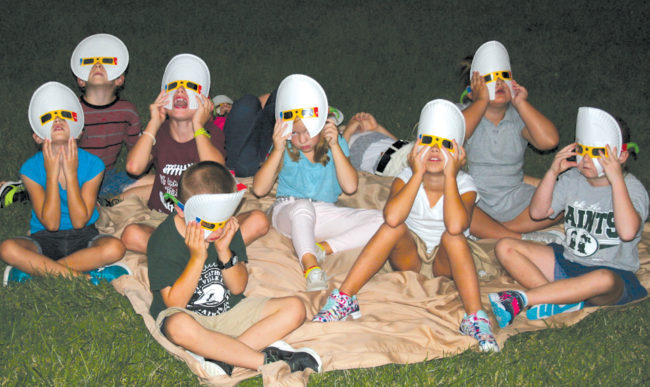Science teacher Adrienne Rolf didn’t have a lot of time to prepare her students for the big solar eclipse on August 21, so she made sure she hit the main points.
Safety and the amazingness of God’s creation.
“We briefly discussed that a God who can turn day into night and back again for less than a minute can do anything! What battle can you face that God cannot reverse?” said Rolf.
Rolf, a first and second grade teacher at St. Ann Catholic School in Nashville, stayed up late the night before the eclipse making extra safe eyewear for her students made from NASA-approved glasses and paper plates. The paper plates reduced the chance of the youngsters’ glasses slipping off. Older students were allowed to wear ball caps to school for extra protection.
St. Ann’s was one of many diocesan schools that let students take a break from classes to go outside and witness the eclipse. Students in Nashville had prime view too, with clear sunny skies.
“It’s really interesting,” said Meredith Anderson, 10, who interrupted the interview to note that, wow, it was really getting dark!
Cheers erupted in the grassy lot next to the school as darkness approached and the corona appeared around the moon. The air cooled several degrees in the darkness. Then, no sooner had the sun begun shining, the mugginess returned.
“It’s really cool,” said Gwen Niedbalski. “It’s the first time I’ve ever seen a solar eclipse.”
Around 1:30 p.m. the students returned to their classrooms for a post-eclipse party featuring Sun Drop soda and Moon Pies.
“I’ve been learning about the eclipse for a long time because I really like science,” said Josephine Bronke, 10.
The total eclipse, the first of its kind in 99 years, began Aug. 21 in Oregon at 10:18 a.m. PDT and ended in South Carolina at 2:43 p.m. EDT after going over Idaho, Wyoming, Nebraska, Kansas, Missouri, Illinois, Kentucky, Tennessee, Georgia, North Carolina and South Carolina.







